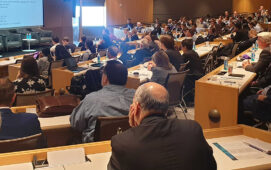
Interoperability and low code/no code technologies on the trading desk are increasingly recognised as modern approaches that contribute to building successful, agile trading platforms. So how can firms implement these technologies effectively to enhance the user experience and reap some real business benefits? And how do they foster a culture that supports the necessary innovation to bring about such change?
This was the theme of a panel discussion at the A-Team Group’s recent TradingTech Summit London, moderated by interoperability expert Reena Raichura, ex-head of product solutions at interop.io and now the founder of Finergise, a fintech advisory company. Joining her on the panel were Will Winzor Saile, Partner, Execution Analytics and Architecture at Redburn Atlantic; Cathy Gibson, Global Head of Trading at Ninety One; Jon Butler, CEO of Velox; and Rob Moffat, Senior Technical Architect, FINOS.The session commenced with a straw poll indicating that while many in the audience were familiar with the concepts of interoperability and low code/no code development frameworks, very few were actually using the technologies. “A good sales opportunity!” quipped one panelist, who went on to give a brief explanation of how low code/no code tools are essentially abstractions that allow developers to write less code, thus becoming more productive and efficient, achieving faster results with less errors. But also possibly with less flexibility, he noted.
The concept of interoperability was summarised as an environment where multiple applications are able to seamlessly integrate, both at the UI level and on the back-end, working together as one to simplify and speed up workflows, again with the results of increased productivity and reduced inefficiencies.
Addressing the challenges
Panelists discussed various challenges that could be alleviated by interoperable/low code/no code frameworks, such as the difficulty of transforming extensive raw data from multiple platforms into valuable insights, the inefficiencies that traders often face due to the lack of integration between trading platforms, and the need for a more efficient desktop setup, particularly problematic during the recent pandemic as traders working remotely had to rely on just one or two screens rather than their usual bank of four or more.
To address the challenge of integrating diverse applications built on different technologies, common data models and data standards are needed, which is why FDC3 (Financial Desktop Connectivity and Collaboration Consortium), a lightweight, baseline standard for financial desktop interoperability, was introduced in 2017 and is now being increasingly adopted by application developers. And the FINOS badging program ensures that all ‘FDC3-compliant’ vendors run the standard to a specific compatibility level.
The panel also discussed challenges around technology procurement and vendor lock-in. Extensive InfoSec, legal, due diligence, and RFP processes can sometimes be so time-consuming, said one panelist, that by the time the technology is implemented, it may already be outdated. Moreover, some vendors can exploit the situation, making it difficult for the firm to switch providers after investing so much effort in the onboarding process.
Interoperability helps address that challenge by allowing for the inclusion of smaller providers and thus offering a more flexible approach.
Total interop
The industry also faces difficulties due to businesses being structured in many layers of silos, said one panelist, who suggested that to function effectively across such silos, three key elements are required: desktop interoperability to connect workflows across applications; server interoperability to integrate server-side data and functionality not present in desktop applications; and the addition of new functions to update legacy systems, often achieved through low-code/no-code solutions. Together, these three elements create ‘total interop’, a comprehensive interoperability framework that enables seamless operation across previously isolated segments.
An example was given of a recently completed total interop project, where the firm’s initial aim was to integrate market data with its trading platform to eliminate the need for traders to manually re-key data between applications. A low code/no code approach was used to handle user authentications and gather necessary live trading and static data, such as client and stock information. This result of the integrations is that traders can now access comprehensive context on-demand; by clicking an order, they can instantly view historical trades, calls, analyst data, and watchlists related to that stock, all within their current workflow.
It was noted however, that the advantages of system integration should extend beyond just simplifying tasks for traders. Ideally, the information provided should also inform trading decisions, enhance execution strategies, and improve client results. The goal shouldn’t merely be to cut down inefficiencies, but also to reduce operational risks and enhance overall business outcomes.
Where to start?
For firms looking to move forward with interoperability and low code/no code frameworks, what are the first steps?
According to panelists, before any implementation of new technology, it’s crucial to identify the specific problem it’s meant to solve, and address that first. Focus on the workflows, analyse and map them out to identify the pain points, and then address those first. Then, recognise that a solution designed for one purpose, e.g. a trading desk application, can also benefit other departments such as sales and analysts, and roll it out accordingly.
However, it’s essential to have buy-in from all levels within the organisation. Ensure that adequate budgeting and organisational focus are in place to carry the project to fruition, with the rewards likely to become most apparent toward the end. While celebrating early successes, such as completing the first phase, is understandable, allowing distractions to divert focus could result in just another legacy system that may require replacement within a few years. The key is to maintain focus throughout the project’s lifespan.
Also, there needs to be a balance between stability and flexibility. So reach a consensus on what elements shouldn’t change, and then build flexibility on top of those within a mutually agreed-upon framework. That makes it easier for everyone to progress.
Subscribe to our newsletter





